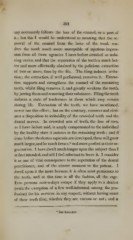Page 395 - My FlipBook
P. 395
391
oay necessarily follows the loss of the enamel, or a part of
it ; but this I would be understood as meaning, that the re-
moval of the enamel from the bone of the tooth ren-
ders the tooth much more susceptible of injurious impres-
sion from all those agencies I have before detailed as indu-
cing caries, and that the separation of the teeth is much bet-
ter and more effectually obtained by the judicious extraction
of two or more, than by the file. The filing induces irrita-
tion ; the extraction, if well performed, removes it. Extrac-
tion supports and strengthens the enamel of the remaining
teeth, whilst filing removes it, and greatly weakens the teeth,
by jarring them and removing their substance. Filing the teeth
induces a state of tenderness in them which may remain
during life. Extraction of the teeth, we have mentioned,
never has this effect ; but on the contrary, removes and obvi-
ates a disposition to irritability of the crowded teeth and the
dental nerves. In crowded sets of teeth, the loss of two,
as I have before said, is amply compensated to the individual
by the healthy state it induces in the remaining teeth ; and if
done before thedentes sapientia are developed, these will grow
much larger, and be much firmer,* and more perfect in their or-
ganization. I have dwelt much longer upon this subject than I
at first intended, and still I feel reluctant to leave it. I consider
it as one of vital consequence to the reputation of the dental
practitioner, and of the utmost moment to the patient. I
dwell upon it the more because it is often most pernicious to
the teeth, and at this time is all the fashion, all the rage.
Few persons now-a-days escape if they apply to a dentist
(with the exception of a few well-informed among the pro-
fession) for his services in any respect, without having some
of their teeth filed, whether they are carious or not ; and a
* See Koecker.


